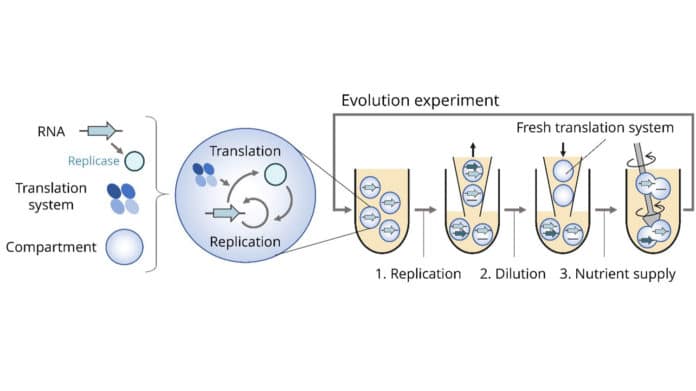Introducing self-evolving RNA created by scientists at the University of Tokyo. It offers insights into how simple biological molecules can lead to the emergence of complex lifelike systems.
This self-evolving RNA can replicate, diversify, and develop complexity.
An origins-of-life scenario depicts Darwinian evolution from self-replicating molecules, such as RNA, toward complex living systems. This step-by-step change possibly eventually led to the emergence of life.
Although there have been many discussions about this theory, it has been challenging to physically create such RNA replication systems. In this study, scientists performed long-term evolution experiments of RNA that replicate using a self-encoded RNA replicase. They explained how they observed the transition from a chemical system towards biological complexity.
Project Assistant Professor Ryo Mizuuchi said, “We found that the single RNA species evolved into a complex replication system: a replicator network comprising five types of RNAs with diverse interactions, supporting the plausibility of a long-envisioned evolutionary transition scenario.”
For this study, scientists used a unique RNA replication system that can undergo Darwinian evolution. It is a self-perpetuating process of continuous change based on mutations and natural selection. This allows different characteristics to emerge and the ones adapted to the environment to survive.
Mizuuchi said, “Honestly, we initially doubted that such diverse RNAs could evolve and coexist. In evolutionary biology, the ‘competitive exclusion principle states that more than one species cannot coexist if competing for the same resources. This means that the molecules must establish a way to use different resources one after another for sustained diversification. They are just molecules, so we wondered if it were possible for nonliving chemical species to develop such innovation spontaneously.”
“The simplicity of our molecular replication system, compared with biological organisms, allows us to examine evolutionary phenomena with unprecedented resolution. The evolution of complexity seen in our experiment is just the beginning. Many more events should occur towards the emergence of living systems.”
“The results could be a clue to solving the ultimate question that human beings have been asking for thousands of years — what are the origins of life?”
Journal Reference:
- Ryo Mizuuchi, Taro Furubayashi, Norikazu Ichihashi, “Evolutionary transition from a single RNA replicator to a multiple replicator network,” Nature Communications: March 18, 2022, DOI: 10.1038/s41467-022-29113-x
